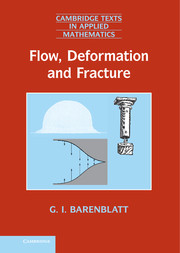 Flow, Deformation and Fracture
Flow, Deformation and Fracture Book contents
- Frontmatter
- Dedication
- Contents
- Foreword
- Preface
- Introduction
- 1 Idealized continuous media: the basic concepts
- 2 Dimensional analysis and physical similitude
- 3 The ideal incompressible fluid approximation: general concepts and relations
- 4 The ideal incompressible fluid approximation: analysis and applications
- 5 The linear elastic solid approximation. Basic equations and boundary value problems in the linear theory of elasticity
- 6 The linear elastic solid approximation. Applications: brittle and quasi-brittle fracture; strength of structures
- 7 The Newtonian viscous fluid approximation. General comments and basic relations
- 8 The Newtonian viscous fluid approximation. Applications: the boundary layer
- 9 Advanced similarity methods: complete and incomplete similarity
- 10 The ideal gas approximation. Sound waves; shock waves
- 11 Turbulence: generalities; scaling laws for shear flows
- 12 Turbulence: mathematical models of turbulent shear flows and of the local structure of turbulent flows at very large Reynolds numbers
- References
- Index
6 - The linear elastic solid approximation. Applications: brittle and quasi-brittle fracture; strength of structures
Published online by Cambridge University Press: 05 June 2014
- Frontmatter
- Dedication
- Contents
- Foreword
- Preface
- Introduction
- 1 Idealized continuous media: the basic concepts
- 2 Dimensional analysis and physical similitude
- 3 The ideal incompressible fluid approximation: general concepts and relations
- 4 The ideal incompressible fluid approximation: analysis and applications
- 5 The linear elastic solid approximation. Basic equations and boundary value problems in the linear theory of elasticity
- 6 The linear elastic solid approximation. Applications: brittle and quasi-brittle fracture; strength of structures
- 7 The Newtonian viscous fluid approximation. General comments and basic relations
- 8 The Newtonian viscous fluid approximation. Applications: the boundary layer
- 9 Advanced similarity methods: complete and incomplete similarity
- 10 The ideal gas approximation. Sound waves; shock waves
- 11 Turbulence: generalities; scaling laws for shear flows
- 12 Turbulence: mathematical models of turbulent shear flows and of the local structure of turbulent flows at very large Reynolds numbers
- References
- Index
Summary
The problem of structural integrity
The science of studying the strength of structures (i.e. structural integrity), traditionally known as the strength of materials (this term, as we will see, is not quite adequate) appeared like Athena from Zeus' head. It was created by Galileo Galilei, and was presented in his book Dialogues Concerning Two New Sciences (Galilei, 1638), which appeared, by the way, not in his home country, Italy, but in Leiden, The Netherlands. He was able to overcome the Catholic Church's prohibition to publish anything by sending parts of his manuscript to Leiden via his friends. Galilei gave the following definition of the subject of this new science: “New science, treating the resistance which solid bodies offer to fracture.” It is remarkable that now, nearly 400 years since its publication, this definition sounds quite modern. Roughly speaking, the problem is to determine the limiting load which a structure is able to carry. The goal of the tensile test, shown in Figure 5.1 and taken from his book (Galilei, 1638), was to determine the limiting load.
Robert Hooke's fundamental paper published 40 years later, in 1678, which as we saw in the previous chapter laid the foundation of the theory of linear elasticity, marked, strictly speaking, a deviation from the path formulated by Galilei. In fact, this paper founded the science treating the deformation of elastic solid bodies due to the action of loads applied to them. This is a remarkable, very important, but different problem.
- Type
- Chapter
- Information
- Flow, Deformation and FractureLectures on Fluid Mechanics and the Mechanics of Deformable Solids for Mathematicians and Physicists, pp. 101 - 123Publisher: Cambridge University PressPrint publication year: 2014


